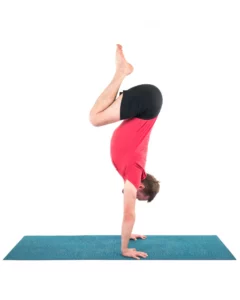How to Be Enough

Article At A Glance
In 1980, I was thirty-seven years old, divorced, a single parent with a full-time job in broadcasting and twenty-one credits toward a master’s degree in communications. Picture that with the caption: “Middle class, African-American woman/feminist, tries to do it all and prove herself competent, capable, connected and enough to be a credit to the race.” That is a heavy burden, and it weighed heavily on me. The cues I was getting from society and my family fed the directive to do it all, but inside I felt crazy. Beneath my struggling and juggling, I was constipated and stressed. I developed TMJ (temporal mandibular joint dysfunction). There was not enough time, not enough energy, and not enough of me, to go around and do all that was expected of me and all that I expected of myself. It felt like I was being ripped in half. I needed to find an answer to the question, “What does it mean to be enough?”

“You are enough. You are so enough. It is unbelievable how enough you are.”
—Quote from Mary Setrakian made famous by Sierra Boggess
Yoga Taught Me How to “Be Enough”
I figured out that if I could recognize or create an internal sense of contentment, I would be able to manage my existential angst and be enough, at least to myself. Some people find self-esteem and actualization in church, some in the creative process, and others in sports. I found mine in yoga.
The physicality of it appealed to me enormously. It felt like dancing. I loved to dance. It relaxed me. I needed to relax. It was a perfect fit. I was hooked. I bought books and tapes and I practiced alone, waiting for enlightenment and bliss.
Over time, I “enlightened up” a few degrees. I got that I could not “do it all” without risking my health and sanity. I gave up business suits and heels along with several committees and board positions—and watched external validation from a number of people and organizations melt away like cold butter on a hot summer sidewalk. Did I need that validation anymore? Could I be a credit to the race on my own terms, in my own voice, and still be me? I didn’t know, but I felt myself inching closer to a resolution.
How Yoga Brought Me to Myself
It was at a yoga weekend in New York’s Catskill Mountains when the idea of being enough shifted from an intellectual concept to a cellular understanding. It was during a sweat-popping practice.
“Hang in there,” said the teacher, “Breathe. Feel your power. Let me hear some deep sighs.”
I struggled to hold up my body on one foot and one hand in a side arm balance. I sighed and hung in through alternate leg lifts. Glued to the ground from chin to pelvis, I inhaled both my legs off the ground and felt them float up into Locust Pose (Salabhasana). I ached with the effort, but I groaned and sighed and squeezed and held on just a bit longer than I thought I could.

At last, Savasana! Relaxation! “Welcome the benefits of the universe,” the instructor said. Her voice was soft, soothing, and musical. “Feel yourself melt into the ground. Breathe deeply. Inhale through the head; roll the breath down the body. Exhale it out through the toes. Relax.”
Being away from home and family, with work responsibilities on hold, I found myself, in that moment, halfway between sleep and wakefulness, floating somewhere between here and there at the same time. Grace, bliss, surrender, and contentment!
A Gradual Process
It’s been a long process. When I look back, I realize that it took 37 years for the threads of external directives, striving and feeling not enough, to tie themselves into knots big enough to feel. Does it matter that it took another 37 years to untie those knots and let the threads dissolve? Nope. In the end, the only thing that matters is that I’ve found the discipline to work through the knots moment-by-moment, bit-by-bit, and thread-by-thread. 
Today, I am a lot better at managing stress. I haven’t been constipated in years. My TMJ bite plate sits unused on the top shelf of the medicine cabinet. My yoga practice is much gentler and more contemplative these days and is as important to me as breathing.
I no longer think that enlightenment will come suddenly, bliss me out and whisk away my struggles. I rejoice in the fact that underneath the African, underneath the American, and underneath the woman, is a being, who can occasionally and surprisingly “be here now.” I can rest amid the chaos and be present in my life with its problems and joys in those moments. I can experience it, and myself at the same time. I am competent, capable, connected, and authentic, a credit to universal consciousness in all its forms. And that is enough.
Also, read...
Free Yoga Video: Breathing for Pelvic Floor Health: Two Practices to Deepen Your Breath
How Healthy Is Your Nervous System: Polyvagal Theory Made Simple
Related courses
Breath as Medicine: Yogic Breathing for Vital Aging
Yoga and Myofascial Release: Releasing Chronic Tension with the Bodymind Ballwork Method

Beth Gibbs, MA, is a faculty member at the Kripalu School of Integrative Yoga Therapy. She holds a master’s degree in Yoga Therapy and Mind/Body Health from Lesley University in Cambridge, MA. She is the author of Soul Food, Life-Affirming Stories Served with Side Dishes and Just Desserts, Enlighten Up! Finding Clarity, Contentment, and Resilience in a Complicated World and Ogi Bogi, The Elephant Yogi, a therapeutic yoga book for children. Beth is an experienced workshop leader and public speaker. She blogs at bethgibbs.com



